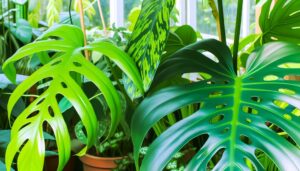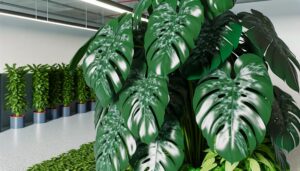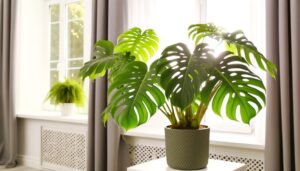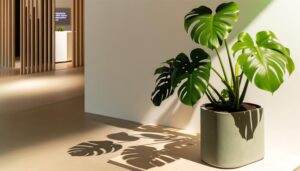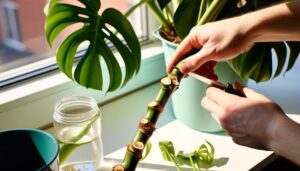Monstera Peru Vs Monstera Adansonii
You're comparing Monstera Peru and Monstera Adansonii, both thriving in tropical rainforests of Central and South America. Monstera Peru features thick, leathery leaves with a glossy finish, while Monstera Adansonii has thinner, fenestrated leaves with a matte texture.
Peru is more self-supporting with compact leaf structure, whereas Adansonii exhibits vining behavior, often growing on other plants. For cultivation, both require indirect sunlight, high humidity, and aerated substrates.
Combatting common pests like spider mites and aphids is vital. Monstera Peru's dark green, quilted leaves and Adansonii's light-filtering fenestrations offer distinct aesthetic appeal.
There's more to explore on their unique characteristics!

Key Takeaways
- Monstera Peru has thick, leathery, glossy leaves, while Monstera Adansonii has thin, perforated, matte leaves.
- Monstera Peru grows compactly with self-supporting leaves; Monstera Adansonii exhibits vining behavior and climbs.
- Monstera Peru's leaves can reach up to 12 inches; Monstera Adansonii's leaves max out around 8 inches.
- Monstera Peru clings to tree trunks, whereas Monstera Adansonii often grows epiphytically on other plants.
- Both species require high humidity, indirect light, and well-aerated substrates for successful propagation and cultivation.
Origin and Natural Habitat
Both Monstera Peru and Monstera Adansonii, originating from Central and South America, thrive in tropical rainforest ecosystems rich in humidity and indirect sunlight. You'll find these species in the understory layer, where they benefit from dappled light filtered through the dense canopy.
Monstera Peru is endemic to Peru's lowland rainforests, where it clings to tree trunks using aerial roots for stability. Monstera Adansonii, on the other hand, is widespread across various regions, including Mexico and Panama. It exhibits epiphytic behavior, meaning it often grows on other plants, deriving moisture and nutrients from the air.
Both species utilize these strategies to conserve water and maximize nutrient uptake, critical for survival in their native, competitive environments.
Leaf Shape and Texture
You'll notice that Monstera Peru exhibits thick, leathery leaves with a glossy, almost corrugated texture, whereas Monstera Adansonii boasts thinner, perforated leaves with a smooth, matte finish.
The leaf size of Monstera Peru tends to be more compact and robust, offering a stark contrast to the larger, fenestrated leaves of Monstera Adansonii.
This difference in leaf morphology distinctly influences their respective light absorption and transpiration rates.
Leaf Size Comparison
When comparing the leaf size of Monstera Peru and Monstera Adansonii, you'll notice that Monstera Peru typically exhibits larger, thicker leaves with a leathery texture, whereas Monstera Adansonii features smaller, thinner leaves with a more delicate, perforated appearance. The substantial foliage of Monstera Peru is characterized by robust, dense leaf structure, contributing to its impressive size.
Consider the following distinctions:
- Leaf Size: Monstera Peru leaves can reach up to 12 inches, while Monstera Adansonii leaves usually max out around 8 inches.
- Thickness: Monstera Peru's leaves are significantly thicker, providing a more substantial feel.
- Shape: Monstera Adansonii's leaves are fenestrated, featuring characteristic perforations that enhance their delicate visual appeal.
Understanding these differences helps in identifying and cultivating each species effectively.
Texture and Feel
Monstera Peru's leaves display a leathery, robust texture with a dense, almost waxy surface, while Monstera Adansonii's leaves possess a more delicate, perforated structure that feels thinner and more fragile to the touch.
When examining Monstera Peru, you'll notice its epidermal cells are tightly packed, contributing to its rigidity and glossy appearance. The cuticle layer is notably thickened, enhancing its durability.
In contrast, Monstera Adansonii's leaves are fenestrated, with conspicuous holes that reduce the overall leaf mass. The lamina is more pliable, and the veins are more pronounced, giving it a lace-like, fenestrated morphology.
These anatomical differences result in a tactile divergence, with Monstera Peru feeling more substantial and Monstera Adansonii offering a more intricate, delicate sensation.
Growth Patterns
When analyzing growth patterns, you'll notice Monstera Peru exhibits larger, more robust leaves compared to the delicate, fenestrated foliage of Monstera Adansonii. Monstera Peru tends to grow more compactly, while Monstera Adansonii displays pronounced vining behavior, often requiring structural support.
Understanding these differences in leaf size and vine growth habits is essential for optimizing cultivation techniques.
Leaf Size Differences
You'll notice distinct variations in leaf size and growth patterns between Monstera Peru and Monstera Adansonii, stemming from their unique genetic makeup and environmental adaptations.
Monstera Peru exhibits robust, leathery, and thicker leaves that can span a substantial width, demonstrating its capacity for water retention and resilience.
Monstera Adansonii, conversely, features more delicate, fenestrated leaves with numerous perforations that optimize light penetration and air circulation. These morphological differences can be summarized as:
- Leaf Thickness: Monstera Peru's leaves are considerably thicker and more rigid.
- Leaf Perforations: Monstera Adansonii's leaves are distinctively fenestrated.
- Surface Texture: Monstera Peru has a glossy, smooth texture, while Monstera Adansonii's surface is softer and more pliable.
Understanding these traits helps you appreciate the evolutionary strategies each plant employs.
Vine Growth Habits
In examining vine growth habits, it's evident that Monstera Peru manifests a more compact, self-supporting growth pattern, whereas Monstera Adansonii exhibits a vigorous climbing habit facilitated by its aerial roots.
Monstera Peru's internodes are shorter, leading to a denser, bushier appearance. Its growth is primarily vertical, with minimal lateral expansion.
Conversely, Monstera Adansonii displays elongated internodes, enabling it to climb surfaces like moss poles or trellises efficiently. The aerial roots of Monstera Adansonii actively seek out support structures, attaching firmly to enhance vertical growth.
Both species possess epiphytic tendencies, but Monstera Adansonii's aggressive climbing nature contrasts sharply with Monstera Peru's relatively restrained growth. Understanding these distinct growth patterns aids in best placement and support for each plant type.
Light Requirements
Providing optimal light conditions for both Monstera Peru and Monstera Adansonii is crucial for their photosynthesis and overall well-being. Both species thrive in bright, indirect light, which replicates their natural environment under the canopy of tropical forests. Direct sunlight can burn their leaves, resulting in photoinhibition and cellular harm. However, inadequate light will hinder chlorophyll production and impede growth.
To enhance light exposure, consider the following:
- East or West-facing windows: These offer abundant indirect light without harsh midday sun.
- Sheer curtains: These scatter strong light, preventing leaf scorching while maintaining adequate brightness.
- Artificial grow lights: These are effective during periods of low light or in dimly lit areas.
Consistently monitoring light levels guarantees strong, vibrant plant health.
Watering Needs
To maintain peak hydration for Monstera Peru and Monstera Adansonii, keep the soil consistently moist but not waterlogged. Aim for a balance by implementing a systematic watering regime. Use a moisture meter to monitor soil hydration levels accurately. Water when the top inch of substrate feels dry to the touch.
Overwatering can lead to root rot, a condition characterized by brown, mushy roots and yellowing leaves. Conversely, underwatering results in leaf curl and browning edges. Employ tepid, dechlorinated water to avoid root shock. Make sure proper drainage by utilizing pots with drainage holes.
Humidity levels should be maintained between 60-80%, as both species thrive in higher humidity environments. Mist foliage regularly, but avoid excessive wetness to prevent fungal issues.
Soil Preferences
Perfect soil for Monstera Peru and Monstera Adansonii should be well-draining and rich in organic matter to support their robust root systems and nutrient uptake. You should aim for a mix that retains moisture yet avoids waterlogging, which can lead to root rot.
Consider incorporating the following components to achieve the best soil structure:
- Perlite: Improves aeration and drainage.
- Coco coir: Retains moisture while providing good drainage and root oxygenation.
- Compost: Supplies essential nutrients and enhances soil fertility.
A balanced pH level, ideally between 5.5 and 7.0, ensures nutrient availability and healthy growth. Regularly check the soil's consistency and adjust the components to maintain an ideal environment for your Monstera's needs.
This customized approach ensures that both species thrive in your care.
Common Pests and Diseases
Both Monstera Peru and Monstera Adansonii are susceptible to common pests like spider mites, aphids, and mealybugs, which can cause significant damage if not promptly managed. Spider mites often create fine webbing and stippling on leaves. Aphids excrete honeydew, promoting sooty mold growth. Mealybugs appear as cottony masses, causing chlorosis and stunted growth.
To combat these pests, use insecticidal soap or neem oil. Systemic insecticides can also be effective.
Additionally, these plants may suffer from fungal infections like powdery mildew and root rot. Ensure proper drainage and avoid excessive watering to prevent these issues.
Regularly inspect your Monstera for early signs of infestation or disease, so you can intervene before significant damage occurs.
Propagation Methods
Propagating Monstera Peru and Monstera Adansonii typically involves stem cuttings, a method that guarantees genetic consistency and allows for efficient clonal reproduction. To begin, select a healthy stem with at least one node and aerial roots. Cut below the node using sterilized scissors to prevent contamination.
Maintain ideal rooting conditions:
- Substrate: Use a well-aerated medium like perlite or sphagnum moss.
- Humidity: Keep high humidity levels to promote root development.
- Light: Provide indirect, bright light to stimulate photosynthesis without scorching the cutting.
Once roots develop, transplant the cutting into a nutrient-rich potting mix.
Monitoring for pests and maintaining proper moisture levels will help ensure successful propagation and healthy growth. This method guarantees that you replicate the parent plant's unique characteristics precisely.
Aesthetic Appeal
Characterized by their striking foliage, Monstera Peru and Monstera Adansonii offer unique aesthetic qualities that can enhance any indoor plant collection.
Monstera Peru, with its coriaceous leaves, exhibits a deeply veined, almost quilted texture, providing a robust, architectural presence. The foliage's dark green hue and rigid structure contribute to a statuesque appearance.
In contrast, Monstera Adansonii, known for its fenestrated leaves, features numerous perforations that create a lighter, airier look. These holes, or fenestrations, allow light to filter through, casting intricate shadows. Adansonii's leaves are thinner and more delicate, offering a visually dynamic contrast.
Both species excel in adding visual interest, but your choice depends on whether you prefer the substantial texture of Peru or the delicate intricacy of Adansonii.
Conclusion
In comparing Monstera peru and Monstera adansonii, you'll find their unique traits coincidentally align with diverse interior ecosystems.
While Monstera peru's rugged, leathery leaves thrive in low light, Monstera adansonii's fenestrated foliage prefers bright, indirect light.
Both require well-draining soil and moderate watering, yet each species has distinct pest susceptibilities and propagation methods.
Ultimately, your choice between these Monstera species will hinge on their aesthetic appeal and specific environmental adaptability, harmonizing botanical diversity with your individual preferences.


